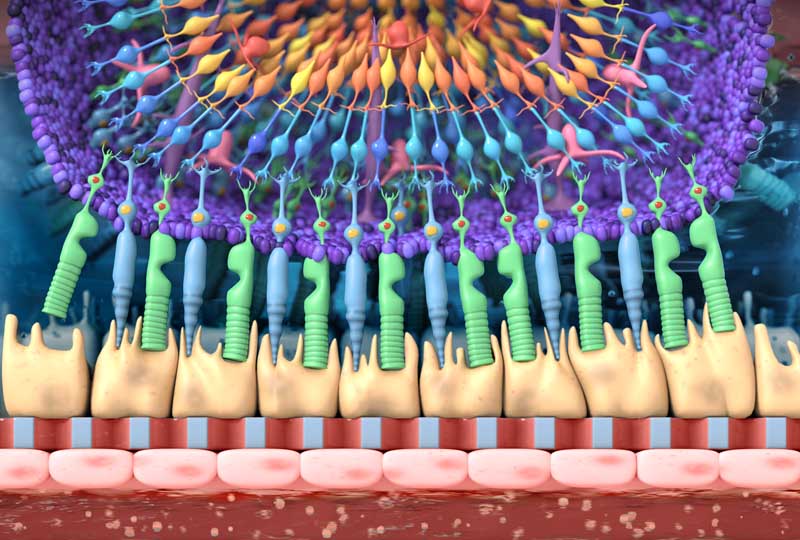Retina-on-Chip:
Retinal damages or diseases such as retinitis or age-related macular degeneration significantly impact the everyday life of affected individuals, very often leading to sever vision impairments or blindness. For a large number of eye diseases, there are currently neither cures nor effective treatments available, partly due to the scarcity of suitable model systems. Therefore, in this project, we are working on a physiological Retina-on-Chip by merging hiPS cell technology, organoids and Organ-on-Chip concepts. By combining the biological self-assembly capabilities of retinal organoids with the precisely controllable assembly in microfabricated modules provided by engineering approaches, we are developing an in vitro model capable of recapitulating the complex stratified (and interconnected) tissue architecture of the human retina. Due to a toolbox of in situ and ex situ analysis options, the platform is extremely versatile and features potential applications for drug development, toxicity screening, disease modeling, and personalized medicine.
Choroid-on-Chip:
The interplay between the choroidal vascular network and the immune system are key events of several the ocular diseases and drug induced ocular toxicity. Most of the available in vitro models of the human eye lack the immune component and vascularization. We have developed a human cell-based in vitro model of the choroid layer of the eye that integrates key choroidal cell types – melanocytes, retinal pigmented epithelial cells and microvascular endothelial cells – in a microphysiological environment mimicking in vivo tissue architecture and vasculature-like perfusion. Immunocompetence is achieved by perfusion of immune cells (PBMCs) through the endothelial channel. The choroid-on-a-chip model is being developed for pharmacology and toxicology applications covering drug testing and in vitro disease modelling of choroidal inflammatory diseases such as uveitis and wet AMD.
Funding: NC3Rs-CrackIT;
Publications
M. Cipriano, K. Schlünder, C. Probst, K. Linke, M. Weiss, M.J. Fischer, L. Mesch, K. Achberger, S. Liebau, M. Mesquida, V. Nicolini, A. Schneider, A.M. Giusti, S. Kustermann, P. Loskill
Human immunocompetent choroid-on-chip: a novel tool for studying ocular effects of biological drugs
Commun. Biol., 2022, 5, 52, https://doi.org/10.1038/s42003-021-02977-3
L. Mesch, N. Pashkovskaia, V. Cora, S. Pars, S. Corti, M. Cipriano, P. Loskill, E. Koertvely, S. Kustermann, M. Mesquida, A. Kleger, S. Liebau, K. Achberger
Aged human iPSC-RPE organoid cultures display hallmarks of drusen formation
BioRxiv, 2024, under review, https://doi.org/10.1101/2021.10.12.463899
K. Achberger*, M. Cipriano*, M. Düchs*, C. Schön*, S. Michelfelder, B. Stierstorfer, T. Lamla, S.G. Kauschke, J. Chuchuy, J. Roosz, L. Mesch, V. Cora, S. Pars, N. Pashkovskaia, S. Corti, S.-M. Hartmann, A. Kleger, S. Kreuz, U. Maier, S. Liebau, P. Loskill
Human stem cell-based retina-on-chip as new translational model for validation of AAV retinal gene therapy vectors
Stem Cell Rep., 2021, 16, 2242-2256, https://doi.org/10.1016/j.stemcr.2021.08.008
K. Achberger*, C. Probst*, J.C. Haderspeck*, S. Bolz, J. Rogal, J. Chuchuy, M. Nikolova, V. Cora, L. Antkowiak, W. Haq, N. Shen, K. Schenke-Layland, M. Ueffing, S. Liebau, P. Loskill
Merging organoid and organ-on-a-chip technology to generate complex multi-layer tissue models in a human Retina-on-a-Chip platform
eLife, 2019, 8, e46188, https://doi.org/10.7554/eLife.46188
J.C. Haderspeck*, J. Chuchuy*, S. Kustermann, S. Liebau, P. Loskill
Organ-on-a-Chip technologies that can transform ophthalmic drug discovery and disease modelling
Expert Opin. Drug Discov., 2019, 14, 47-57, https://doi.org/10.1080/17460441.2019.1551873




